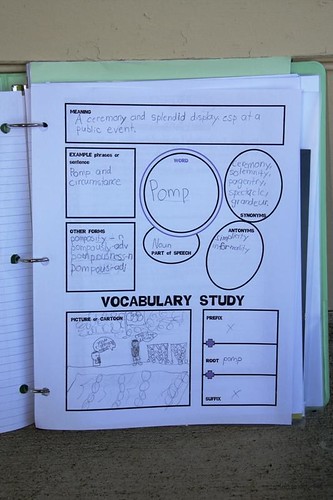Sometimes people ask me what we use for language arts, and I don’t have an easy answer. That’s because I make it up. When you say that, you get some strange looks.
I do have some resources such as poetry anthologies, editing practice, and vocabulary workbooks. But for the most part, I wing it.
I know that making it up is scary for many people. I totally understand that. I feel that way about math. I need something to guide me. But language arts comes naturally. (I was an eighth grade language arts teacher for 7 years in the pre-China years.)
In this post I will walk you through an example of the types of lessons that I use for Sprite’s language arts (6th grade).
On our trip to NYC, we saw the Statue of Liberty from afar. Somewhere along the way we got a postcard with the poem inscribed inside the pedestal of the statue —The New Colossus by Emma Lazarus. It’s the one that says,
Give me your tired, your poor,
Your huddled masses yearning to breathe free,
The wretched refuse of your teeming shore.
Send these, the homeless, tempest-tost to me.
I instantly knew that this bit of American history in the form of a poem would be a fantastic learning opportunity to tie history and poetry together.
Once we were home, I read the poem outloud to Sprite as I normally do for our daily poetry study. She narrated it orally as best she could. Then, looking at the poem, she identified some unfamiliar words. One of those was pomp which she analyzed using the printable vocabulary notebooking page from The Notebooking Fairy. She prefers using the dictionary on her Kindle for these kinds of exercises.
The poem itself became the subject for copywork. And the finished piece was filed in Sprite’s poetry notebook.
We did a little research on the Colossus of Ancient Greece, one of the Seven Wonders of the Ancient World, and talked about the contrast between that Old Colossus and this New Colossus. Finally this wonderful Youtube version of the poem helped to cement understanding of the poem.
This short lesson spanned two days and integrated these disciplines in a natural outgrowth of a family trip:
- poetry
- vocabulary
- history
- dictionary skills
- research skills
Along with this integrated lesson, we did these other language arts activities both days:
- Daily Proofreading Exercise
- Grammar Practice (diagramming sentences)
- Spelling Power
- Vocabulary Workbook
- Independent Reading Time


I’ve had to be very confident in my conversation about homeschooling as a defense mechanism. What is it with people grilling about the details of homeschooling and the constant questions about sufficiency? I find it an exhausting reassurance task to explain myself to those who do not know anything or little about homeschooling. Sorry. Mini-vent!! 😉
I create our curriculum too and trying to explain it is a thorn in my side. lol.
I always believe that as homeschoolers we need to do what works for us (our children and ourselves). You are fortunate to have that teaching background. I feel confident enough to pull things together myself too and the funny thing is, when I do that, our “lessons” are always more memorable than any curriculum.
Great post!
I don’t have a teaching background but a lot of our lessons come naturally as well. It *is* hard to answer the question, “What do you use in your homeschool?” Short answer, “Everything”. This isn’t the answer people want to hear. Then I say “Charlotte Mason”. Not too helpful either. I hate that question more than the socialization question! LOL
This is a great idea and so relevant to your trip and what you were studying. The information is retained much easier as well. Thanks for sharing the ideas!
With language arts, I feel the way you do with math. I’m less likely to wing it. But math is a different story. I feel I know it well enough to follow her lead and scaffold whenever necessary. It’s a much enjoable way to learn.
Sorry for the typo. I didn’t catch it until after I pressed return!